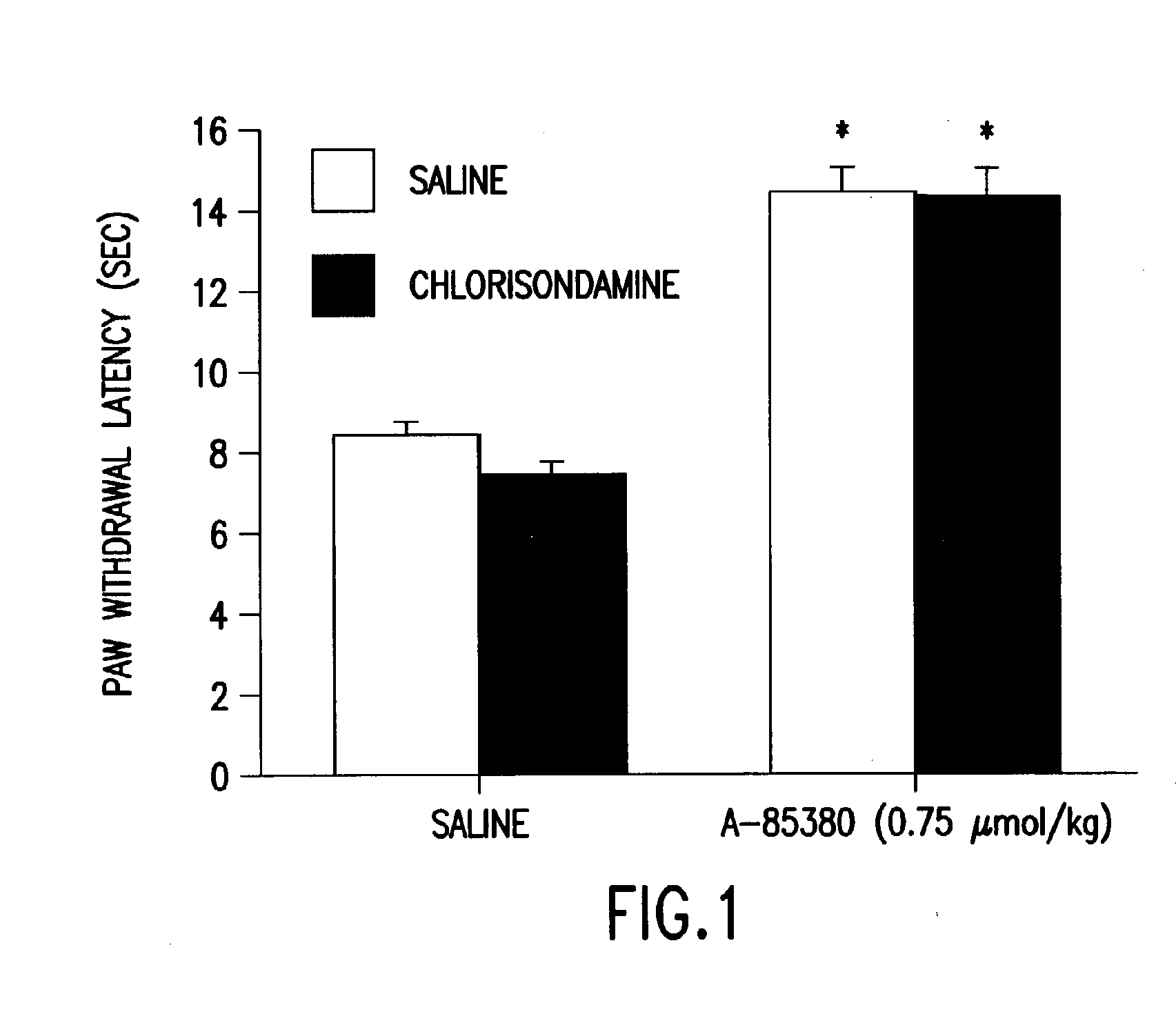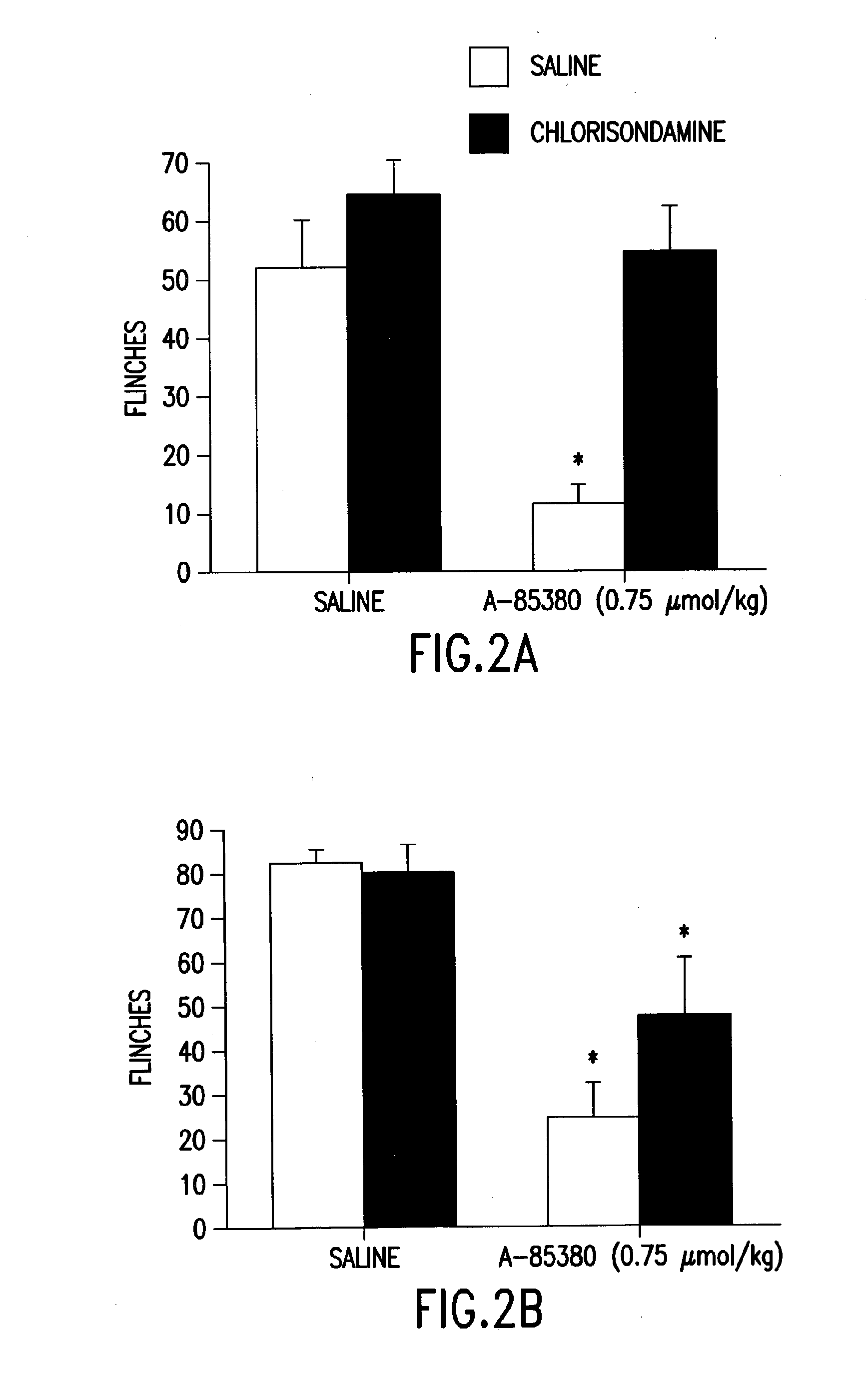Treatment of neuropathic pain
a neuropathic pain and pain technology, applied in the field of neuropathic pain treatment, can solve the problems of difficult clinical treatment of conditions, high risk of centrally-mediated side effects, and difficult treatment of anticonvulsants for patients, and achieve the effect of reducing side effects
- Summary
- Abstract
- Description
- Claims
- Application Information
AI Technical Summary
Benefits of technology
Problems solved by technology
Method used
Image
Examples
example 1
[0054]The effect of systemically administered chlorisondamine in a model of acute thermal pain was examined. Chlorisondamine, a quaternary NNR quasi-irreversible antagonist that does not readily cross the blood-brain barrier was used to identify the central and peripheral actions of A-85380. The effect of systemically administered chlorisondamine (0.4 μmol / kg, i.p.) on A-85380 (0.75 μmol / kg, i.p.) was assessed. As shown in FIG. 1, i.p. chlorisondamine had no effect on the antinociceptive action of A-85380 in acute thermal pain (interaction of agonist and antagonist, p=0.42, effect of antagonist, p=0.35).
example 2
[0055]The effect of centrally and systemically administered chlorisondamine in a model of persistent pain was examined. Using phase two of the formalin model of persistent pain, chlorisondamine (10 μg) was administered i.c.v. 24 hours prior to the systemic administration of A-85380. The i.c.v. administered chlorisondamine completely blocked the analgesic effects of systemically administered A-85380 (0.75 μmol / kg, i.p.; interaction of antagonist and agonist, p=0.048; effect of antagonist / agonist treatment combination p=0.0002; FIG. 2A). In contrast, when chlorisondamine was administered systemically 40-50 minutes prior to the formalin injection, there was no significant attenuation in A-85380-induced analgesia in phase two of the formalin test (interaction of agonist and antagonist, p=O. 12, effect of antagonist p=0.19; FIG. 2B).
example 3
[0056]The effect of the NNR Agonist A-85380 in a model of neuropathic pain was examined. Systemically administered A-85380 induced a dose dependent anti-allodynia in rats with neuropathy secondary to the tight ligation of spinal nerves L5 and L6 (interaction of dose and time, p<0.0001, effects of A-85380 at 15, 30 and 60 minutes, p<0.0001), see FIG. 3. A-85380 at 0.5-1.0 μmol / kg, i.p. induced behaviors such as prostration and ataxia immediately following injection. However, these effects abated by the 15 minute time point and did not interfere with behavioral testing.
PUM
| Property | Measurement | Unit |
|---|---|---|
| volumes | aaaaa | aaaaa |
| volumes | aaaaa | aaaaa |
| current | aaaaa | aaaaa |
Abstract
Description
Claims
Application Information
 Login to View More
Login to View More - Generate Ideas
- Intellectual Property
- Life Sciences
- Materials
- Tech Scout
- Unparalleled Data Quality
- Higher Quality Content
- 60% Fewer Hallucinations
Browse by: Latest US Patents, China's latest patents, Technical Efficacy Thesaurus, Application Domain, Technology Topic, Popular Technical Reports.
© 2025 PatSnap. All rights reserved.Legal|Privacy policy|Modern Slavery Act Transparency Statement|Sitemap|About US| Contact US: help@patsnap.com



